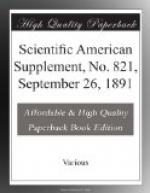As a variant of the process I sometimes add to the usual amount of nitric acid an additional one one-hundredth part of phosphoric acid on account of its beneficial nutritive powers—that is to say, to one hundred parts of grain one part of nitric acid and one one-hundredth part of phosphoric acid.
While my improved process is based on the well-known converting power of acids on starch, I am not aware that it has ever been applied in the manner and for the purposes I have described. For example, sulphuric and hydrochloric, also sulphuric and nitric, acids have been employed in the manufacture of glucose; but in every such case the resulting products were not capable of superseding those obtained by the existing methods of saccharification used in distilleries. In my process, on the other hand, the product is so capable. Not only may malted grain be entirely omitted, but more fermentable products are formed and the products of fermentation are purer. The saccharification being more complete, there are less intermediary and nonfermentable dextrins, and the yield of spirits is therefore increased. Malted grain being omitted or used in reduced quantity, there is less lactic acid and few or foreign ferments to contaminate the fermenting mass; also, the formation of higher alcohols than the ethyl alcohol is almost totally suppressed. Consequently the final yield of spirits is purer in quality and requires little or no further purification. Also, further, the nitrates themselves acting as nutrients to the yeast cells, these become more active and require less nutrition to be taken from the grain.
* * * * *
SPECTROSCOPIC DETERMINATION OF THE SENSITIVENESS OF DRY PLATES.
After describing other methods of determining the sensitiveness of plates, Mr. G.F. Williams, in the Br. Jour. of Photo., thus explains his plan. I will now explain the method I adopt to ascertain the relative sensitiveness of plates to daylight. Procure a small direct vision pocket spectroscope, having adjustable slit and sliding focus. To the front of any ordinary camera that will extend to sixteen or eighteen inches, fit a temporary front of soft pine half an inch thick, and in the center of this bore neatly with a center bit a hole of such diameter as will take the eye end of the spectroscope; unscrew the eyehole, and push the tube into the hole in wood, bushing the hole, if necessary, with a strip of black velvet glued in to make a tight fit. By fixing the smaller tube in the front of camera we can focus by sliding the outer tube thereon; if we fix the larger tube in the front, we should have to focus inside the camera, obviously most inconvenient in practice. Place the front carrying the spectroscope in situ in the camera, and rack the latter out to its full extent; point the camera toward a bright sky, or the sun itself, if you can, while you endeavor




